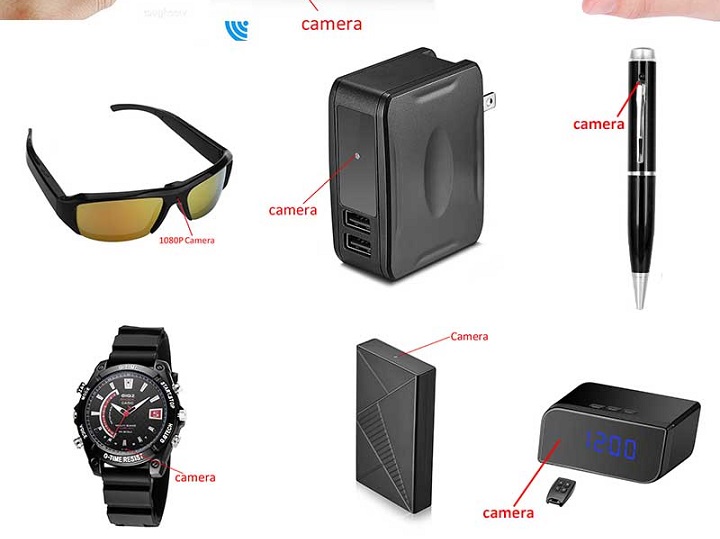What are the Different Types of Hidden Cameras

Due to the fact that the global economy is thriving, we’re living in bigger homes, we’re earning more money, we own prettier things, but we’re also living in a bit more dangerous times. It’s perfectly fine to feel a little ‘paranoid’ about your personal security, the security of your loved ones, and the security of your belongings and valuables.
In this article, we’re going to talk about the main types of hidden cameras you can use to keep an eye on the things you cherish the most.
There are two main types of hidden cameras from which all the other types derive from – audio surveillance cameras and visual surveillance cameras. Of course, the technology has advanced to the point where most modern cameras are now capable of recording sound and image at the same time, so the standard categorization makes no sense anymore.
Basically, there are many types of hidden cameras, but the most notable ones are body-worn spycam, Wi-Fi cameras, Nanny spy-cam cameras, and Night-Vision cameras. All of these cameras are legal to use in most cases, and all of them are supposed to be used in different kinds of environments.
Body-worn cameras
Body-worn cameras are the alpha and omega of mobile espionage. These little gadgets are typically less than an inch big and weigh no more than a couple of ounces, which makes them perfect for taking photos and shooting videos ‘on the go’.
Depending on the brand and the model you opt for, the quality of the images and videos you’ll be able to get will vary. After all, body-worn cameras are designed for quick in-and-out situations where you’ll still be able to remain stealthy and inconspicuous.
One of the best things about most body-worn cameras is that they sport a soundless method of operation. They don’t produce any clicking sounds or flashing lights that would give you away.
This might be a double-edged sword, actually, as you won’t be able to know if you actually started (or finished) recording.
Wi-Fi cameras
Wi-Fi cameras offer the functionality of a standard-issue camera, but they also offer a substantially higher level of utility and convenience due to the fact that you don’t need to install them.
People who are searching for cameras typically look at the corners of the ceiling, as that’s where most standard cameras are (so as to provide the best field of view). That’s not the case with Wi-Fi cameras, as you’ll be able to position them wherever you want as long as they’re in the range of Wi-Fi connection.
The ability to freely position a Wi-Fi camera wherever you wish also allows you to be creative in regard to how you wish to mask its presence. You can hide it between a stack of books, or you can tape it under a desk. Alternatively, you’ll be able to throw numerous objects on top of each other and camouflage the camera with the illusion of squalor.
Wi-Fi cameras are operated via remote controller devices, which means that you’ll be able to use all of its features from a safe distance, just like you would navigate the settings of a regular camera.
Nanny Cameras
The reason why ‘Nanny Cameras’ is called as such is that they are meant to replace actual ‘nannies’. They are mostly used by parents who wish to keep watch over their children while they’re away from home.
Nanny Cameras are completely legal simply because they’re typically used to monitor one’s own home; they aren’t really all that functional in most other scenarios.
The main benefit of a Nanny cam is that they are petite and lightweight. This means that they can be installed pretty much anywhere – you can put them on a TV, you can install them in your drywall, or even mount them on the toys your child is rarely using.
What really separates Nanny Cameras from other hidden camera types is that they typically come supplied with a motion-sensor device. This means that the camera will either have a fixed FOV (field of view) or even be offline until any kind of motion is detected.
The camera is capable of following the source of those movements, and most models come supplied with an ‘alarm’ feature that goes off whenever the sensor goes off.
Night Vision Camera
The main benefit of night vision cameras is that they come supplied with an infra-red optic sensor that detects temperature. What’s more, the main ‘screen’ of the camera is incomparably brighter than that of an average camera by default, allowing you to clearly see everything in pitch-black environments.
On the flip side, the main drawback of a night vision camera is that they typically record videos of poorer quality.
Frequently Asked Questions
Having a lot of options to choose from is great, but it can also be slightly confusing. If you have additional questions regarding the different types of hidden cameras, don’t worry, you’re not alone. Here’s what other people wondered about these cams:
Does the size of a camera have an impact on the quality of the video?
Basically, smaller cameras are easier to hide, but they also feature smaller lenses and sensors; this typically means that the quality of the videos you film will be slightly lower than average in turn.
Can you use a Wi-Fi camera to check on your home? Are they different from Nanny Cameras?
People regularly use Wi-Fi cameras for this purpose. Checking up on your kids or pets is easier with a Wi-Fi camera than by using a Nanny Camera because the latter will only activate if something is moving.
In other words, a Wi-Fi camera is a proactive device that gives you a bit more control while a Nanny camera is a form of precaution that gives you slightly more security.
Most hidden cameras can be used as standard cameras, but due to the fact that they’re supplied with substantially different features, don’t expect to film high-quality videos or take good photos.




